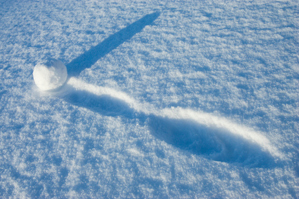The physics of a snowball

If you grew up in the Northeast you know that there are good days for making snowballs and there are bad days for making snowballs. You know that sometimes, despite your best efforts to squeeze the snow into a perfectly rounded orb, it just won’t stick.
J. Murray Gibson, founding dean of the College of Science, told me why. The problem, he said, is that the temperature of the snow is too cold for you to weld it into a self-contained ball.
Welding may seem like a weird term to use here, but Gibson said that’s exactly what you’re doing when you make a snowball or even a snowman. As you squeeze the snow into a more compact space, it melts from a solid into a liquid. When you release it, the liquid freezes, fusing the loosely connected snowflakes in your hand into a larger solid ball.
It turns out water is the only commonly occurring material in the universe that does this…and it’s therefore the only material that could ever be used to make your buddy Frosty, no matter how many corncob pipes you’ve got lying around.
Here’s the deal: water, unlike any other material out there, is less dense in its solid state than in its liquid state. It’s less dense because the unique shape and properties of water molecules make it very hard to build a dense solid crystal. It’s why ice floats in a cup of water and it’s why trying to compress solid snow actually causes it to liquefy and so take up less space. Most other materials are denser in their solid form, so no amount of pressure will get them to liquefy.
When it’s super cold outside, the amount of pressure needed to melt a handful of snow is greater than our hands are able to create. So it’s on those below zero days that you’ve probably been least successful in your snowman building efforts. Temps right around freezing are your best bet. Also, try not to let it sit for too long, Gibson said. If you do, larger ice crystals form which present a whole other set of snowball making problems that I won’t go into now.

It’s clearly too cold to be making a snowball. This person should just go inside and have some hot chocolate. Photo via Thinkstock.
While snowballs are of obvious significance, especially this time of year, the same phenomenon that makes them possible is also what makes life on earth possible. Yes of course water is important for biology for a dozen different reasons, not the least of which is its incredible stability and inertness. But something I didn’t really think about until our chat is the fact that it’s also important for creating the geological character of our planet.
When water seeps inside the cracks in the ground and then freezes, it expands. This causes the rock to smash apart, Gibson said, and it is singlehandedly responsible for erosion. Without erosion, he continued, we’d have no flat plains or soil, which turn out to be really important for growing food and finding shelter.
But back to the physics of winter fun. Ice skating, Gibson said, is another cold weather activity that we can only enjoy because of water’s unique property to melt when it’s compressed. All of your weight localizes to the sharp edge of your skate’s blade, putting an incredible amount of pressure on the ice, causing it to melt. This creates an almost frictionless environment, which, as Gibson put it, “allows you to glide and slide beautifully for long distances.” (Assuming of course you have the skill not to fall on your backside, which he confesses to lacking, but that’s another story…)






